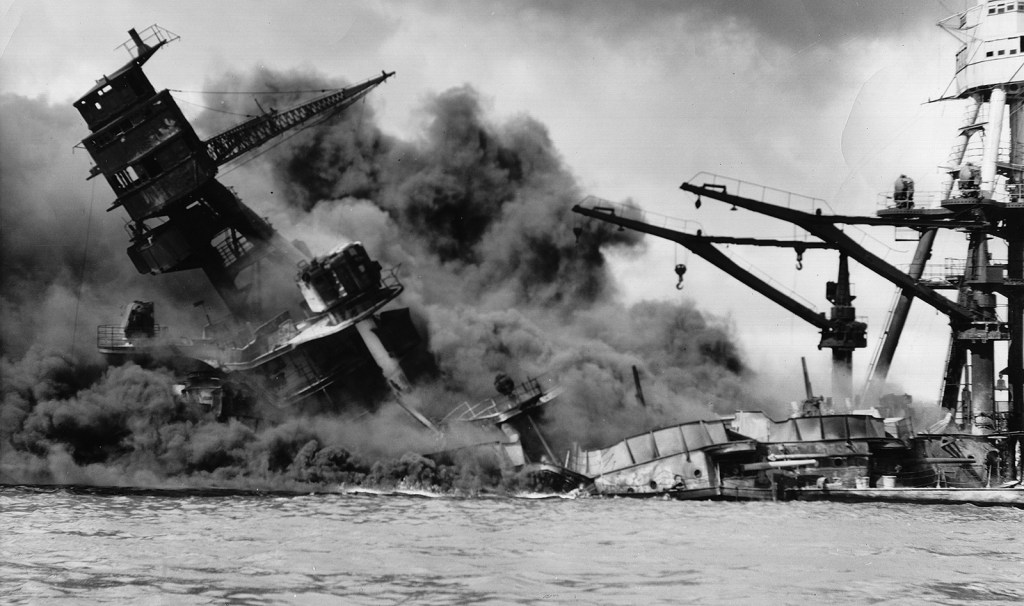“Tora Tora Tora”: The Raid on Pearl Harbor

When the 183 Japanese planes of the first wave approached Pearl Harbor from the north without any resistance from the Americans, LtCmdr Mitsuo Fuchida, the commander of the Japanese air strike, signaled to Adm Nagumo the code words “Tora Tora Tora” (tiger, tiger, tiger) which indicated the attack began with complete surprise. Five minutes later, Cmdr Logan Ramsey, Ops officer of Patrol Wing Two, attempted to get the tail number of a plane he thought was flying recklessly. But he recognized the red “meatball” on the plane’s wing and immediately sent out the radio message in plain English, “Air Raid Pearl Harbor. This is no drill.”
Fuchida had six objectives for the first wave. The first five were Pearl Harbor’s air defenses: Wheeler and Hickham Army Airfields, Ford Island and Kaneohe Naval Air Stations, and Ewa Marine Air Station. Most of the planes on these airfields were destroyed before they could get off the ground. And many even before the ammunition could be distributed to the anti-aircraft defenses, which despite repeated war warnings was still locked up in distant armories. Nevertheless, in the chaos, men fought back, including mechanics on Wheeler who threw wrenches at the low flying Japanese. Or more effectively, Chief Petty Officer John Finn, who pulled a .50 Caliber machine gun from a damaged PBY and fought through 21 separate wounds to earn the first Congressional Medal of Honor of the Second World War. Or an unknown marine at Ewa who stood in the middle of the runway firing his pistol at the low strafing planes. The official Japanese records of the attack refer to him at “The Bravest American”. The Japanese pilots specifically targeted him, like jousting knights, but as far they knew the young marine survived the attack. A large portion of the Japanese casualties at Pearl Harbor came by way of that most mocked and denigrated Army and Marine rank, the second lieutenant; eight of whom courageously took off into the teeth of the Japanese onslaught in far inferior planes to take them on at 20-1 odds.
While the Japanese bombed and strafed the airfields, Fuchida personally supervised his pilots at his sixth and primary objective – Battleship Row. There the eight battleships of the US Battleship Divisions 1, 2 and 4 sat. The surprise attack caught the ship’s crews preparing for the day. On the USS Nevada, the band played for morning colors just as the Japanese attacked. They finished despite being strafed because, “It was inconceivable to break formation during the Star Spangled Banner.” Specially designed low draft Japanese torpedoes struck the Nevada moments later, along with her sisters the USS Arizona, California, West Virginia, and Oklahoma. The torpedoes sank the West Virginia and capsized the Oklahoma. In spite of the surprise, the sailors were a bit more prepared to fight than their land based brethren as they had their ammunition on board. During Sunday morning mass on the cruiser USS New Orleans, the chaplain Lt.jg. Howell Forgy blessed his gunners, and told them to “Praise the Lord and pass the ammunition.” On the West Virginia, Messmate Third Class Doris Miller manned a .50 Cal in the conning tower, a weapon he was unfamiliar with, until his ammunition ran out. Miller would receive a Navy Cross for carrying many of his wounded comrades to safety before the West Virginia sank.
After the torpedo bombers, Japanese dive bombers dropped specially converted 16in armor piercing battleship shells on the giant American targets. They would damage every battleship on the Row, but one hit in particular caused nearly half of the American casualties that day. Like her sisters, the Arizona was a battleship developed for the last war. Her armored citadel, the area that protects the vital areas of the ship, could withstand a hit from largest shell of that time, 14”. One of the dive bombers managed to place its converted 16in shell right above the forward magazine, where it penetrated. Seven seconds later a catastrophic explosion destroyed the ship, killing 1100 sailors instantly.
The entire island seemed to be on fire. In 90 minutes, four battleships and three other ships were sunk, four more battleships, and nine others damaged, 300 aircraft destroyed, and 3700 soldiers, sailors, marines, and civilians were killed or wounded by two waves of Japanese carrier based aircraft. It was still less than what was expected. On the outset, Fuchida gave a flare signal for an hastily planned conventional attack, one configured for an expected American defensive preparedness, instead of the planned signal for the attack in case surprise was complete, which it was as signified by the famous “Tora, Tora, Tora” broadcast. Fuchida’s signal prompted the torpedo bombers to wait a few critical minutes before attacking Battleship Row while the dive and level bombers plastered the airfields. Those few minutes were key: they allowed the crews to secure battle stations and close water tight doors. The torpedo bombers as a result took more casualties and their hits less devastating than they could have been. Consequently, Fuchida wanted a third attack: to destroy the fuel farms, dockyards, and repair facilities, and probably also to correct the sub par, though still devastating, results. But he was overruled by Adm Nagumo: most of the Japanese losses occurred during the second wave, and the American carriers were not in port and therefore an unknown threat. Also, the fuel situation would be critical if the Kido Butai lingered which it would have to do all day if a third strike was launched. By noon, all aircraft were recovered, and the Japanese were racing home.
Nagumo would regret his decision for the rest of the war.

LikeLike
http://l.facebook.com/l.php?u=http%3A%2F%2Fnhhc.maps.arcgis.com%2Fapps%2FMapJournal%2Findex.html%3Fappid%3D90ad202de59d4a5bbf70738e5737c3be&h=pAQHIKW0U
LikeLike
http://usnhistory.navylive.dodlive.mil/2014/12/04/navy-action-reports-tell-the-story-of-pearl-harbor-attack/
LikeLike
http://www.wearethemighty.com/articles/see-the-intense-navy-deck-logs-from-the-pearl-harbor-attack
LikeLike